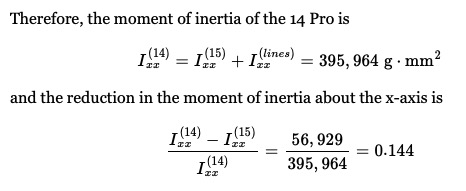
While Apple made much of the iPhone 15 Pro weight reduction, achieved by swapping out the stainless steel frame for a titanium one, it did create something of a mystery.
The weight reduction of the iPhone 15 Pro versus last year’s model is relatively modest, yet almost everyone present at the launch event – including our own Chance Miller – said that they could really feel the difference …
Here are the weights of the two Pro models, per Apple specs:
- iPhone 14 Pro: 206g
- iPhone 15 Pro: 187g
Now, I’m not dissing the achievement: a difference of 19g is quite impressive in engineering terms. At the same time, however, it’s not a lot of weight in terms of perceptibility when held in the hand: It’s only about 9% lighter.
So how is it that media folk at the event so consistently described the new model as feeling significantly lighter? The answer, says a man with a Ph.D. in engineering, is the moment of inertia, also known as angular mass.
These are the terms given to the amount of torque needed to rotate an object about any of its three axes. The more the weight is biased toward the center of an object, the less force it takes to turn it. Conversely, the more of the weight found at the edges of the object, the greater the force needed to turn it.
Because the frame is around the edge of the iPhone, then all that weight is at the outside. If you reduce the weight of the frame, as Apple has done, then you reduce the torque needed to rotate it, even if the actual mass reduction isn’t that great.
And when you’re handling a phone, the force needed to twist and turn it contributes to a sense of weight. Dr. Drang (a pseudonym) did the sums.
Your ability to manipulate a phone is based primarily on its mass, but also on its moment of inertia. And since the reduction in mass when switching from stainless steel to titanium is occurring almost entirely at the perimeter of the phone, the moment of inertia should be reduced more than if the mass were reduced uniformly.

That difference amounts to 14-15% – and that’s a more reasonable amount to be subjectively felt.
Drang does hedge his post by pointing out the approximations involved, but concludes that it’s close enough to explain the phenomenon.
FTC: We use income earning auto affiliate links. More.



Comments